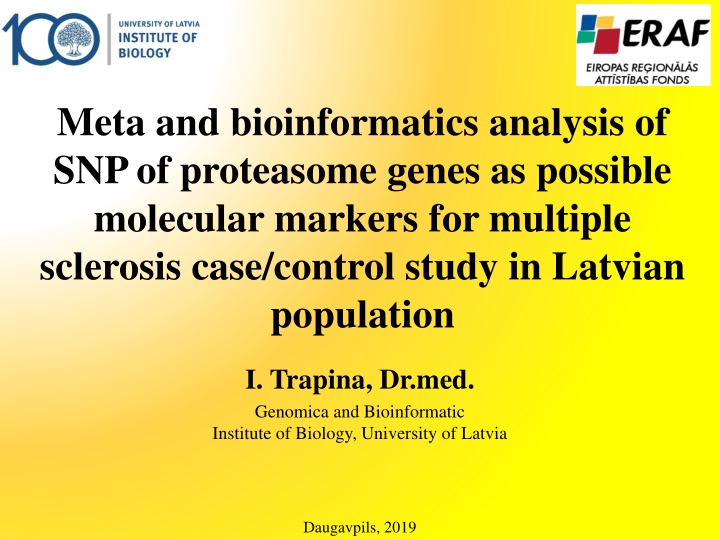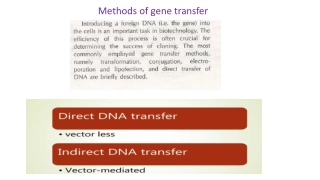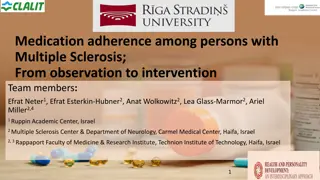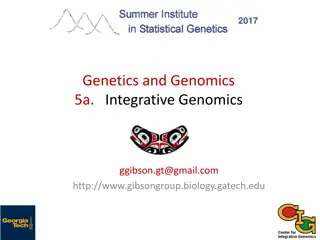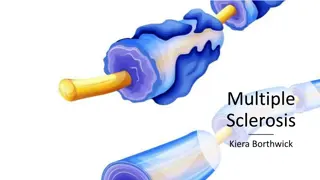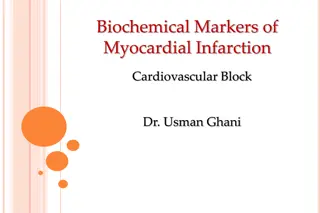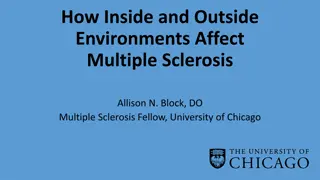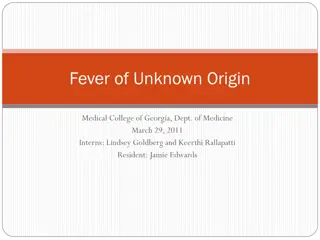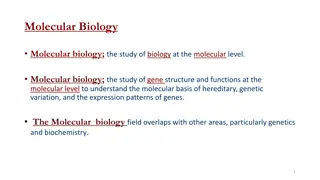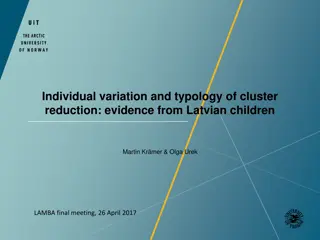Analysis of Proteasome Gene SNPs as Molecular Markers for Multiple Sclerosis in Latvian Population
This study by I. Trapina aims to investigate the prevalence and functionality of SNPs in proteasome genes to assess their potential as molecular markers for multiple sclerosis in the Latvian population. Multiple sclerosis is an autoimmune disease affecting the central nervous system, and the role of proteasomes in immune regulation may have implications for disease development. The research focuses on six specific SNPs in proteasomal genes and utilizes bioinformatics tools for analysis. Understanding these genetic markers could offer insights into the pathogenesis of multiple sclerosis.
Download Presentation

Please find below an Image/Link to download the presentation.
The content on the website is provided AS IS for your information and personal use only. It may not be sold, licensed, or shared on other websites without obtaining consent from the author.If you encounter any issues during the download, it is possible that the publisher has removed the file from their server.
You are allowed to download the files provided on this website for personal or commercial use, subject to the condition that they are used lawfully. All files are the property of their respective owners.
The content on the website is provided AS IS for your information and personal use only. It may not be sold, licensed, or shared on other websites without obtaining consent from the author.
E N D
Presentation Transcript
Meta and bioinformatics analysis of SNP of proteasome genes as possible molecular markers for multiple sclerosis case/control study in Latvian population I. Trapina, Dr.med. Genomica and Bioinformatic Institute of Biology, University of Latvia Daugavpils, 2019
Multiple sclerosis Multiple sclerosis (MS) involves an immune-mediated process in which an abnormal response of the body s immune system is directed against the central nervous system (CNS: brain, spinal cord and optic nerves). Therfore MS is autoimmune inflammatory disease. Within the CNS, the immune system causes inflammation that damages myelin the fatty substance that surrounds and insulates the nerve fibers as well as the nerve fibers themselves, and the specialized cells that make myelin. When myelin or nerve fibers are damaged or destroyed in MS, messages within the CNS are altered or stopped completely. Damage to areas of the CNS may produce a variety of neurological symptoms that will vary among people with MS in four disease courses (types) and severity. The cause of MS is not known, but it is believed to involve geneticsusceptibility, abnormalities in the immune system and environmental factors that combine to trigger the disease.
Possible links between proteasome and multiple sclerosis Proteasomal system: Proteasomes, the multycatalytic protease complexes, play a critical role in the degradation of proteins via ATP/ubiquitin-dependent process or ubiquitin proteasome system, which plays a crucial role in immunity and its disregulation and/or modulation may influence the development and progression of different diseases. 20S proteasome induction with interferon causes replacement of PSMB5, PSMB6 and PSMB1 by LMP2 (PSMB8), LMP7 (PSMB9) and MECL-1 (PSMB10) (multicatalytic endopeptidase complex subunit), respectively, and forms immunoproteasome. Expression of LMP2 and LMP7 genes is decreased in patients with autoimmune diseases. The proteolytic activities of proteasomes are reduced in brain tissue of Multiple sclerosis patients. The 20S proteasome had been identified as a target of the humoral autoreactive immune response and a major autoantigen in MS patients. Jansen et.al, Front. Mol. Neurosci., 2014
Aim of the study To determine the prevalence and possible functionality SNPs of proteasome gene to analyze their usability as molecular markers for multiple sclerosis binding study in the Latvian population.
Materials and methods Six SNPs of proteasomal genes: 1.PSMB8 (LMP7) - proteasome subunit beta 8: I. rs2071543 > NM_004159.4:c.135+427C>A(Gln49Lys) II. rs9357155 > NM_148919.3:c.537+63C>T (G>A) III. rs9275596 > NT_167246.1:g.4138777T>C 2. PSMB9 (LMP2) - proteasome subunit beta 9 I. rs17587 > NM_002800.4:c.179G>A 3. PSMD9 - proteasome 26S subunit, non-ATPase 9 I. rs74421874 > NM_002813.6:c.454-460G>A II. rs3825172 > NM_002813.6:c.454-437C>T Meta analyze of scientific literature Bioinformatical tools: Transcription factor binding site > MatInspector (http://www.genomatix.de) with identity 1,00 of core and >0,85 of matrix DNA bendabilty > bent.it (Vlahovicek et al., 2003; http://pongor.itk.ppke.hu/dna/bend_it.html#/bendit_form) DNA and/or RNA secondary structure > Mfold (Zuker 2003, http://unafold.rna.albany.edu/?q=mfold/DNA-Folding-Form)
Results PSMB8 - rs2071543: NM_004159.4:c.135+427C>A (Gln49Lys) MAF in EUR: 0.15 Transcription factor binding site A C RNA secondary structure A C DNA bendabilty (green line) in areal decreases at change of nucleotide C>A
Results PSMB8 - rs9357155: NM_148919.3:c.537+63C>T (G>A) MAF in EUR: 0.31 Transcription factor binding site G A DNA secondary structure G A DNA bendabilty (green line) in areal increases at change of nucleotide G>A
Results PSMB8 - rs9275596 > NT_167246.1:g.4138777T>C MAF in EUR: 0.14 Transcription factor binding site C T DNA secondary structure T C DNA bendabilty (green line) in areal increases at change of nucleotide T>C
Results PSMB9 - rs17587 > NM_002800.4:c.179G>A MAF in EUR: 0.27 Transcription factor binding site A G DNA secondary structure G A DNA bendabilty (green line) in areal no difference at change of nucleotide G>A
Results PSMD9 - rs74421874: NM_002813.6:c.454-460G>A and rs3825172: NM_002813.6:c.454-437C>T in complete linkage disequilibrium with MAF in EUR: 0.31 for both SNPs (between are 23 bp) Transcription factor binding site rs74421874 rs3825172
Results PSMD9 - rs74421874: NM_002813.6:c.454-460G>A and rs3825172: NM_002813.6:c.454-437C>T G/C A/T DNA secondary structure G/C A/T DNA bendabilty (green line) in areal increases at change of nucleotide G/C>A/T
Conclusions Meta and bioinformatic analysis of selected SNPs of PSMB8 (rs2071543, rs9357155 and rs9275596) , PSMB9 (rs17587) and PSMD9 (rs74421874 and rs3825172) illustratepossibility of using them as molecular markers of multiple sclerosis by genotyping in association study.
Thank you for your attention! SAM No 1.1.1.1/16/A/016 project Determination of proteasome- related genetic, epigenetic and clinical markers for multiple sclerosis
